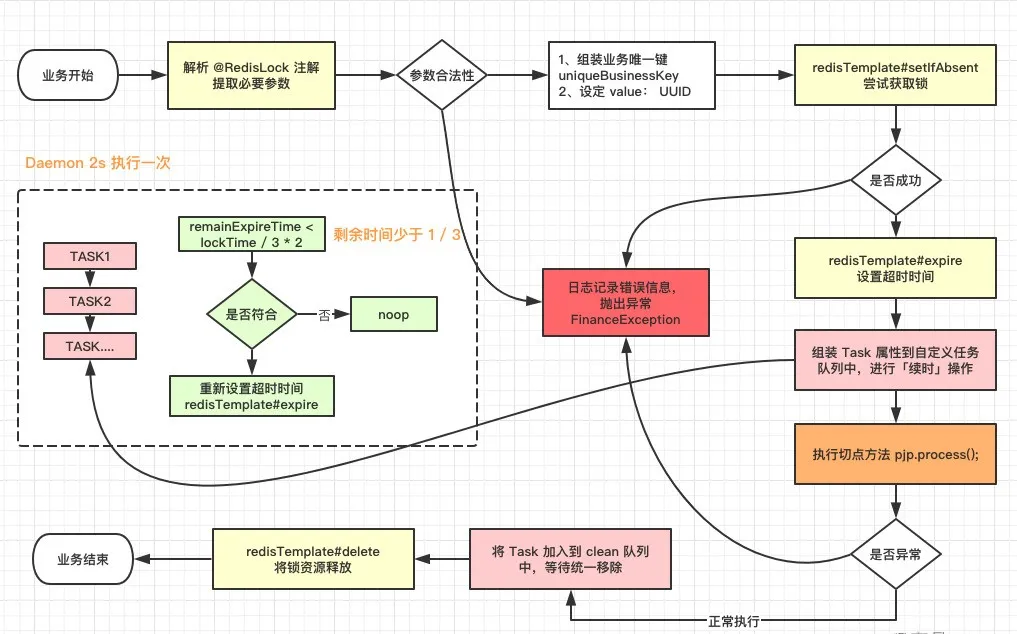1. 业务背景
有些业务请求,属于耗时操作,需要加锁,防止后续的并发操作,同时对数据库的数据进行操作,需要避免对之前的业务造成影响。
2. 分析流程
使用 Redis 作为分布式锁,将锁的状态放到 Redis 统一维护,解决集群中单机 JVM 信息不互通的问题,规定操作顺序,保护用户的数据正确。
梳理设计流程
- 新建注解 @interface,在注解里设定入参标志
- 增加 AOP 切点,扫描特定注解
- 建立 @Aspect 切面任务,注册 bean 和拦截特定方法
- 特定方法参数 ProceedingJoinPoint,对方法 pjp.proceed() 前后进行拦截
- 切点前进行加锁,任务执行后进行删除 key
核心步骤:加锁、解锁和续时
加锁
使用了 RedisTemplate 的 opsForValue.setIfAbsent 方法,判断是否有 key,设定一个随机数 UUID.random().toString,生成一个随机数作为 value。
从 redis 中获取锁之后,对 key 设定 expire 失效时间,到期后自动释放锁。
按照这种设计,只有第一个成功设定 Key 的请求,才能进行后续的数据操作,后续其它请求由于无法获得锁资源,将会失败结束。
超时问题
担心 pjp.proceed() 切点执行的方法太耗时,导致 Redis 中的 key 由于超时提前释放了。
例如,线程 A 先获取锁,proceed 方法耗时,超过了锁超时时间,到期释放了锁,这时另一个线程 B 成功获取 Redis 锁,两个线程同时对同一批数据进行操作,导致数据不准确。
解决方案:增加一个「续时」
任务不完成,锁不释放:
维护了一个定时线程池 ScheduledExecutorService,每隔 2s 去扫描加入队列中的 Task,判断是否失效时间是否快到了,公式为:【失效时间】<= 【当前时间】+【失效间隔(三分之一超时)】
3. 设计方案
经过上面的分析,设计出了这个方案:
 图片
图片
前面已经说了整体流程,这里强调一下几个核心步骤:
- 拦截注解 @RedisLock,获取必要的参数
- 加锁操作
- 续时操作
- 结束业务,释放锁
4. 实操
之前也有整理过 AOP 使用方法,可以参考一下
相关属性类配置
业务属性枚举设定
任务队列保存参数
设定被拦截的注解名字
核心切面拦截的操作
RedisLockAspect.java 该类分成三部分来描述具体作用
Pointcut 设定
Around 前后进行加锁和释放锁
前面步骤定义了我们想要拦截的切点,下一步就是在切点前后做一些自定义操作:
上述流程简单总结一下:
- 解析注解参数,获取注解值和方法上的参数值
- redis 加锁并且设置超时时间
- 将本次 Task 信息加入「延时」队列中,进行续时,方式提前释放锁
- 加了一个线程中断标志
- 结束请求,finally 中释放锁
续时操作
这里用了 ScheduledExecutorService,维护了一个线程,不断对任务队列中的任务进行判断和延长超时时间:
这段代码,用来实现设计图中虚线框的思想,避免一个请求十分耗时,导致提前释放了锁。
这里加了「线程中断」Thread#interrupt,希望超过重试次数后,能让线程中断(未经严谨测试,仅供参考哈哈哈哈)
不过建议如果遇到这么耗时的请求,还是能够从根源上查找,分析耗时路径,进行业务优化或其它处理,避免这些耗时操作。
所以记得多打点 Log,分析问题时可以更快一点。记录项目日志,一个注解搞定
5. 开始测试
在一个入口方法中,使用该注解,然后在业务中模拟耗时请求,使用了 Thread#sleep
使用时,在方法上添加该注解,然后设定相应参数即可,根据 typeEnum 可以区分多种业务,限制该业务被同时操作。
测试结果:
我这里测试的是重试次数过多,失败的场景,如果减少睡眠时间,就能让业务正常执行。
如果同时请求,你将会发现以下错误信息:
 图片
图片
表示我们的锁🔐的确生效了,避免了重复请求。
6. 总结
对于耗时业务和核心数据,不能让重复的请求同时操作数据,避免数据的不正确,所以要使用分布式锁来对它们进行保护。
再来梳理一下设计流程:
- 新建注解 @interface,在注解里设定入参标志
- 增加 AOP 切点,扫描特定注解
- 建立 @Aspect 切面任务,注册 bean 和拦截特定方法
- 特定方法参数 ProceedingJoinPoint,对方法 pjp.proceed() 前后进行拦截
- 切点前进行加锁,任务执行后进行删除 key
本次学习是通过 Review 小伙伴的代码设计,从中了解分布式锁的具体实现,仿照他的设计,重新写了一份简化版的业务处理。对于之前没考虑到的「续时」操作,这里使用了守护线程来定时判断和延长超时时间,避免了锁提前释放。












































